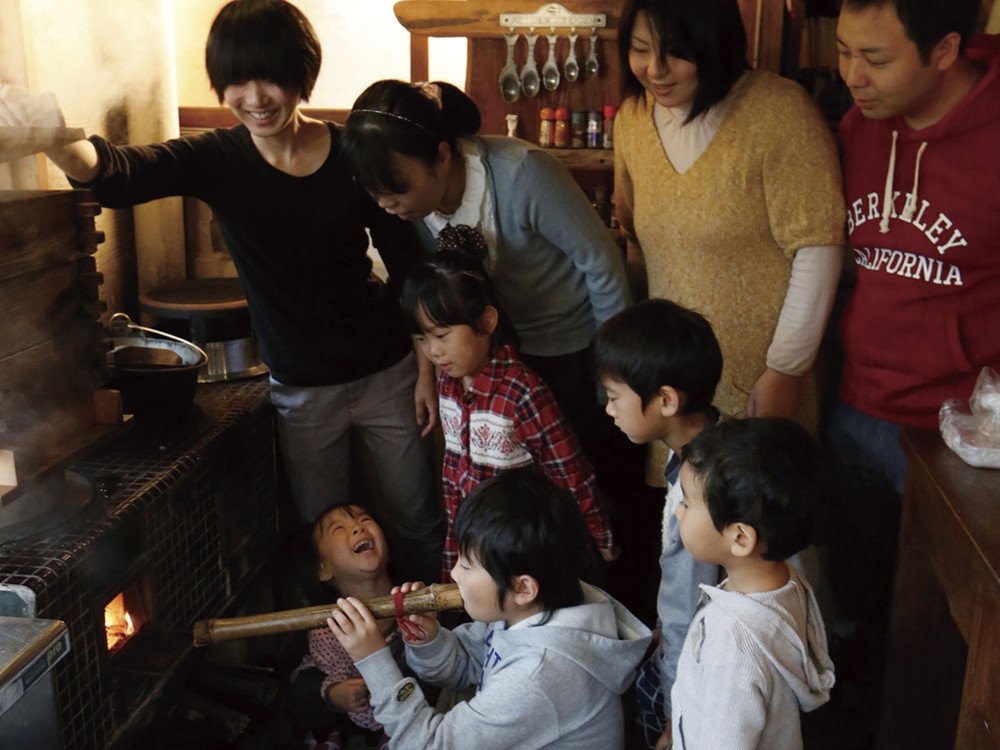Learn about Nature,
Environment,
History, and Culture
[Special Feature]
Introduction of Hands-on Experiences
Making Fires as Part of Life

The children are excited by the cauldron. They do a good job of making a fire.
Feeling a richness within in the "hassle" of old-fashioned living
People in the past, pumped water, cooked rice in cauldrons, and made fires for directly heated baths. Smoke rose from the cauldrons and irori hearth in a home, and the scent told people of meal time. I visited Izumo Koshi Kominkajuku, where one can experience such an old-fashioned life.
Izumo is a town of myth, where the Hii River flows majestically. Izumo Koshi Kominkajuku is located in a remote village where the chorus of frogs can be heard from the rice fields in early summer and morning haze shrouds the land in winter. Architect Toshinori Esumi renovated an old private home and began rural tourism activities to teach the richness of lifestyles of health and sustainability. Given breath by the architect, this old folk house exudes feeling of a comfortable use as a whole as well as in every detail – even hand-made chairs and shelves.
Nostalgic for adults, fresh for children
Living in an old private home, centered on the earthen floor
On this day of my visit, families with young children gathered for a rural experience at the old home with Kominkajuku staff. What interested the children was fire. Modern-day children who are used to an electrified life do not often see fire. However, fires are used here for the irori hearth, cauldrons, fireplace, direct-heated bath, and more. The bright red flames of the fire started under a cauldron make the children say "Wow!" They watch the fire with shining eyes. We decided to use fire to cook boiled rice with meat and vegetables in the cauldron, and boil pork broth and grill fish at the hearth. At a large table on the earthen floor, hands both large and small are making preparations for the meal. At the same time, children can be seen running around in a connected room in back. The floor is tatami mat, so slipping and falling down is no big deal! "Don't break the shoji screens!" A mom calls out in a worried voice. Exchanges like this bring back a forgotten nostalgia.

We're sleeping in this!?
Children who don't know mosquito nets act like they're in a secret base. So much for nap time!
I sink a wooden platform into the direct-heated iron bathtub and climb in. A small bath can be fun!
Hot pizza is ready in the pizza oven in the garden.

Let's ball up the freshly-made rice cake! It's really stretchy.
At the front entrance, pounding rice cakes has begun. A dad experiencing rice cake pounding for the first time pounds the rice with unfamiliar hands, while mom kneads the hot rice cakes. The kids devour the treats happily. At the irori hearth, we enjoyed the food that we had all cooked together.
It was a moment when we felt a richness amid the "hassle," and the happiness that comes with it. There were a lot of smiles.

It's time to eat the food we call cooked, together with the staff of the Kominka Kenkyukai! We slowly grill saury, sea bream, and freshly pounded rice cakes over a charcoal fire. The crackling and smoke of the charcoal and the aroma of the cooking food are part of the feast.
